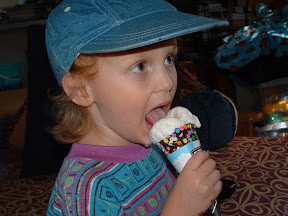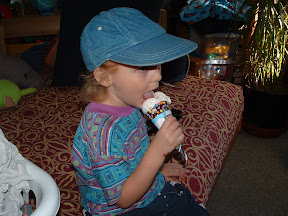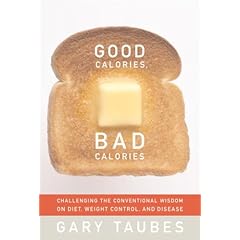
After the show, Ulysses and I walked on State Street. The weather was beautiful, and there was still plenty of time on the meter. We ducked into a few boutiques, where I started my new hunt for a handbag.
I love the one I've been using for the past five years or so, but it's just plain wearing out. It looks like a tapestry, in rich, dusky reds, greens and ochres. It has a leather arm strap with a clever zipper all down its center. The strap actually comes apart into two straps, so you can wear the handbag as a backpack. And it has a zipper, which I've come to regard as a wonderful feature for anyone who stuffs their handbag with digital equipment like cameras and phones and important stuff like a wallet and eyeglasses. It has an inner zippered pouch, which is great for someone who gets a small, important object into their hands, like a flash drive or a little slip of paper with a phone number on it or a twenty-dollar bill, and needs to put it someplace really secure and unforgettable while thinking about twenty other things at the same time.
Worse even than fraying all over, the beloved bag's zipper is starting to give out. Do I put a brand new zipper on a beat-up old bag that was $2 at a yard sale in 2001? Or what?
I managed to get U in and out of some boutiques, and found a few things that were close, but I didn't find the right combo of durability, security in closure, and aesthetic je ne sais quois. Meantime, Ulysses was learning a lot about the varieties of objects and environments that will evoke the phrase, "No touch!"
We came upon the Ben and Jerry's ice cream store. I lifted him in the air to face the cartoon ice cream cone painted on the door. "Would you like some ice cream?" I asked.
"Ice cream?" he said, surprised. He regarded the door, and the picture on it. I let him down and opened the door. He had never been in an ice-cream parlor before. He hadn't been near the ice-cream counter at the Memorial Union since he was an infant. This was a new system to him.
I hoisted him up onto my hip so he could see the ice creams in the big cartons on display behind the glass, maneuvering among the knots of other customers. "Look, Ulysses, ice cream!"
"Ice cream?" he repeated, doubtfully.
"Yes!" I replied. "You say which ice cream you want, and that nice man or that nice lady will give you an ice cream cone." He looked interested. I continued, pointing out his favorite flavors. "Look, there's chocolate ... there's coffee ... vanilla ... wow, that one has a
lot of chocolate." Then, to the people who had entered just behind us: "You go ahead, we're still deciding."
Behind the glass was a display of sample cones available. Waffle, sugar, and so on. Several sugar cones had been dipped in chocolate. Some were covered with candy sprinkles of various types. Ulysses saw one that had little pastel circles of candy, a little smaller than the confetti from an office hole puncher. He tried to reach over the glass for it.
"No, no, " I said, drawing him back, "They give you the cone. You tell them what ice cream you want in it. Anything you want."
Ulysses whimpered and reached toward the cone. "Do you want chocolate?" I asked.
"No. No cho-kit."
"Coffee?"
"No coffee."
"Vanilla?"
"No."
"Strawberry? Raspberry? Look, these have fruit right in them."
"No!" he said, now sounding a little stressed. "No ..." he pronounced it slowly, carefully: "Aw-beh-eee."
And then we were up. The woman came over to wait on us, but I was still pointing and suggesting. Meantime, Ulysses was straining over the glass for the chocolate-dipped cone again, and starting to become frustrated. "Well, let's start with one of these cones," I said, "And we'll figure out the ice cream next."
With a friendly look, the woman turned from us and stepped away.
Ulysses began to panic. The cone was right there in front of him. Obviously this was a store, obviously the thing was for sale, obviously he was being invited to choose a treat. So what were these conflicting things going on? If he wasn't allowed to reach over and get it himself, then why didn't the store person give it to him? Why would she just walk off in the middle of the transaction?
After a few long seconds, she reappeared, having fetched a perfect, confetti-chocolate-dipped cone from a freezer. Ulysses looked relieved. The dissonance was resolved.
Now to the ice cream. Ulysses had moved from "No," to no response at my suggestions. Now the woman behind the counter joined in. "How about strawberry? That's a kid's flavor." She moved her scoop towards the carton, signaling the idea of "let's try this and see if it works."
In my my mind, I felt I could see the future: the uninvited ice cream landing on the perfect cone, staining it with color and moisture, wrecking its purity forever. The future through the eyes of Ulysses. Quickly, I said, "How much is just the cone?"
She looked surprised. "The cone? Oh, ah ... Seventy-five cents. Eighty with tax." I handed her a dollar and collected my change. Ulysses, thrilled, took the cone into his hands. I think he even said, "Thank you." Anyway, one of us did.
Did she make that price up on the spot? Tax and all? Maybe. I didn't mind. She had to say something. I was just glad that she said something that worked. "We might see you again in a few minutes," I said, "After we leave and he realizes that we need to come back here to get the ice cream!"
"Sure," she said, "No problem."
We made our way slowly towards the block where the car was parked. I was balancing the time left on the meter with the time it would take us to get back to the shop once Ulysses realized he had left the ice cream zone with an empty cone. Then I saw how content he was. He held his cone before him, watching it with a smile. I carried him three blocks. Three contented blocks.
"Aren't you going to eat that?" I asked. He looked at me as though I might be a little mad. Perhaps he didn't realize it was edible? No -- it was rich with the smells of chocolate and candy.
"Buttons!" I heard him say, softly, from the back seat, as we drove towards the car wash. We got the Platinum Special: floor mats taken out and cleaned, the interior scrubbed down. We waited inside the car wash building. Ulysses alternated between watching cars being washed through the windows and appreciating the cone in his hand. When the van was ready, he handed me the cone so he could clamber up into his seat. Then he turned and held out his hand for the cone.
We drove towards home. I looked forward to telling Donald the adorable story of how Ulysses just wanted a cone, and not ice cream. Suddenly, I was there, in the future, at home. While I was telling the story, in this future world, Ulysses, also in the future, was headed for the refrigerator. He was reaching up and tugging at the freezer door. And he was handing his cone to me. To be filled with ice cream. In a flash, I understood everything.
There was no ice cream in that freezer.
I made a detour to the local supermarket and stood in line for some Breyer's All-Natural Vanilla. Ulysses stood beside me, holding his cone. He didn't look at what I was buying.
I was taken aback when the clerk said, "$5.99." That sounded like a lot, even for a premium brand. I emptied the change from my pocket and paid -- and realized that I had been ready to pay over $3 for a single serving of premium ice cream at Ben & Jerry's an hour earlier. In that light, six bucks for a half-gallon looked plenty reasonable.
We pulled up to the house. I let Ulysses out. He ran up the steps, ignoring my efforts to interest him in playing in the yard first. I opened the door. He made his way past me, strode to the refrigerator, and reached up as high as he could, tugging at the freezer door.

I opened it and lifted him. He saw the absence of ice cream and looked stricken. I pulled the ice cream out of my tote bag and held it in front of him. He smiled. "Ice cream!" he said, and held up the cone. Patiently, he waited as I found the scoop, undid the plastic band around the lid, and crowned the perfect confetti-chocolate-dipped cone with a perfect scoop of vanilla.
He came back a few minutes later for a refill. The cone was intact.
He got several refills through the afternoon and evening, some hours apart. That was good; it gave the cone a chance to firm up in the freezer. He never bothered with any supper, either.
The perfect cone is still in the freezer. Intact.

The original post/article was by Tara Parker-Pope and titled "Are Kids Getting Too Much Praise?" The URL and article text follows below. The premise of the article intrigued me, but I thought the article itself was put together in a slipshod way. Many of the readers' comments nicely expose various logical gaps.
The examples of good praise vs. bad, for example, I think are all examples of bad praise -- they don't get specific enough with their specificity. More useful than "You did great on your math test," for example, might be, "I notice that you can see how little parts fit into a big pattern," or "Practicing all those addition problems over and over really paid off when you took your math test."
I also like the idea that I got from -- I think it was the book "Easy to Love, Difficult to Discipline," which is a horribly uncatchy title, although it makes sense when you parse it. That author suggests asking a child what they think of a particular accomplishment or creation, rather than automatically jumping in with a compliment. This is especially true, I think, when the topic at hand is something the child might have some uncertainty about. Tuning in to see what sort of emotional guidance the child needs is, I think, better than assuming that cheerleading is always the answer.
For instance, "How do you feel about that math test?" might be a useful conversation opener. Even if the grade was perfect, the answer might be, "I wish I'd studied harder," or "It was too easy -- it didn't feel like I even did anything." Imposing a positive statement like "You did great on that math test!" at the outset might shut out the possibility of real conversation.
Then there's the comparison made between the Korean vs. American kids. The study that the NYT and Scholastic articles describe didn't measure how much praise the children were given. It measured how good the children thought their math skills were, and how good their math skills actually were.
Even if it turned out there was a difference in praise given the two groups, the difference in achievement could result from any number of other factors. So might the difference in how the children describe their skill levels.
Some readers commented that the Korean culture values humility while ours encourages statements of self-confidence. In any case, the fact that few Korean students say they excel at math tells us little.
Here's that NYTimes article:
http://well.blogs.nytimes.com/2007/10/29/are-kids-getting-too-much-praise/